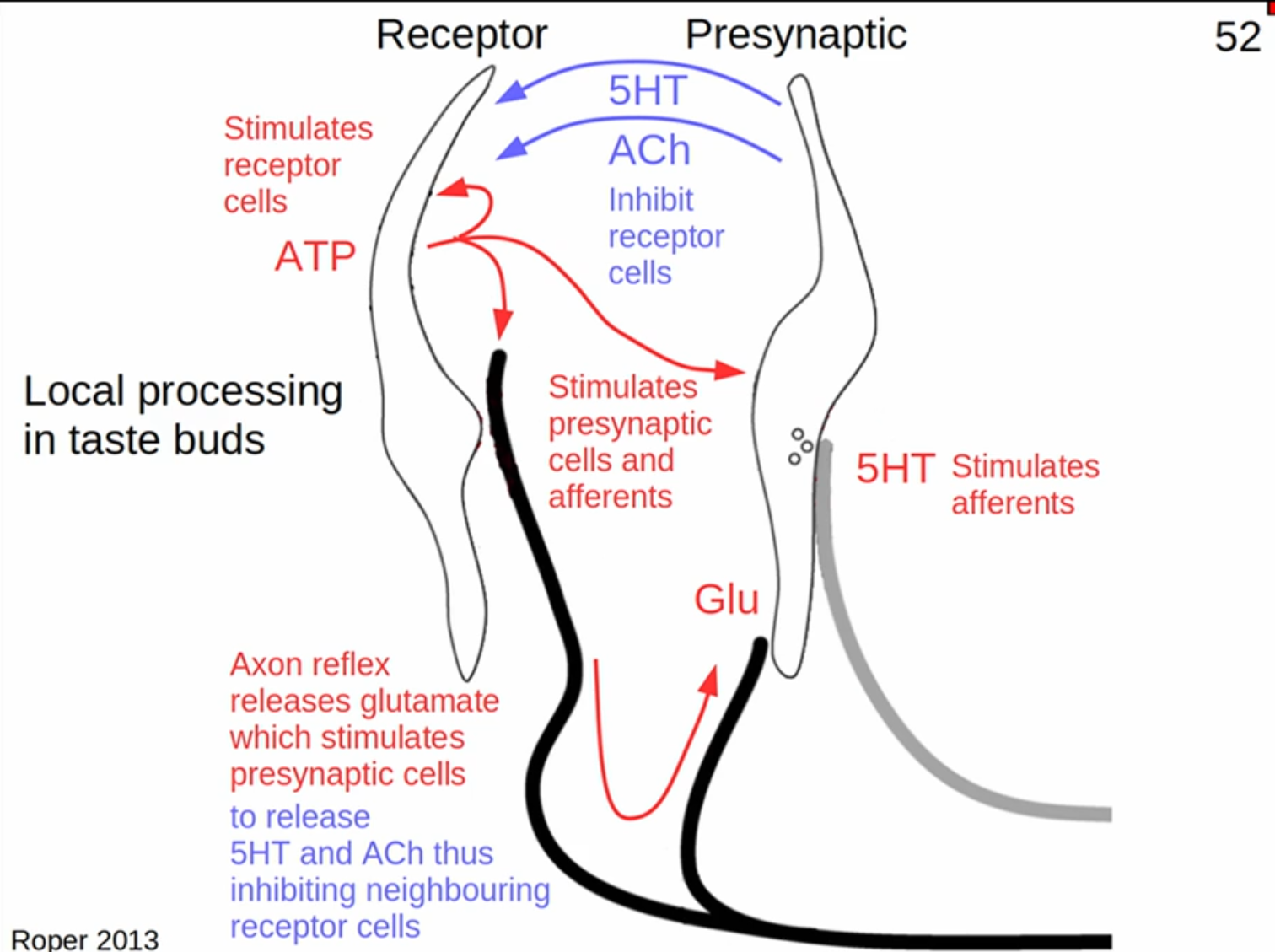Olfaction and taste
1/49
Earn XP
Description and Tags
Cards about the neuroscience of olfaction and taste for IB neurobiology
Name | Mastery | Learn | Test | Matching | Spaced |
|---|
No study sessions yet.
50 Terms
How does olfactory transduction occur?
Odorants dissolve in the mucus covering the the olfactory epithelium
Acitvates a GPCR
cAMP open cation channels
Ca2+ and Na+ enter
Calcium opens Cl- channels
Cl- ion efflux causes depolarisation
How does olfactory adaptation work?
Depolarisation increases Ca2+ concentration
Ca2+ activates Cadmodulin
Cadmodulin reduces receptor sensitivity and decreases the rate of cAMP production by adenylyl cyclase
What is the firing pattern of an olfactory neurone after prolonged exposure?
Bursts of spikes caused by oscillation of Ca2+ and cAMP
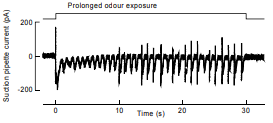
Where is the binding site contained for an olfactory GPCR?
Tm regions 3,4,5
How can the affinity of an olfactory receptor for a certain chemical be investigated?
Infect neurones with an adenovirus carrying your focal receptor
Use an electro-olfactogram to measure the brain activity of infected and non-infected rats when stimulated by this chemical
The difference between the infected and non-infected neurones is the affinity of the focal receptor
What alternatives are there to the cAMP pathway for olfaction?
Some GC-D receptor cells use cGMP and guanylyl cyclase. These project to the necklace glomeruli
Vomeronasal receptors use IP3 pathways activated by PLC
How does an olfactory signal travel to be processed in the olfactory bulb?
Olfactory receptors are long.
Axons pass through the cribiform plate to the olfactory bulb
In olfactory bulb, they excite mitral and tufted cells in olfactory glomeruli.
Where do afferent fibres converge to from an olfactory receptor?
Afferent fibres converge to a medial and lateral glomerulus in each olfactory bulb
How is information processed in the olfactory bulb?
Lateral inhibition.
Mitral cells stimulate granule cells.
granule cells inhibits adjacent mitral cells (including the stimulating cell)
This means that only the most stimulated cells (receptors with the most affinity for each substance)
How does olfactory information leave the olfactory bulb?
Mitral cell axons leave via the lateral olfactory tract.
the anterior olfactory nucleus
How fast do olfactory receptors renew?
every 60 days
Where airbourne odorants detected and how do they get there?
Olfactory epithelium in the nasal cavity
dissolve in mucus
How do more olfactory species increase the surface area of their olfactory epithelium?
Turbinate bones
What is the structure of the olfactory epithelium?
Mucus film
Mixture of olfactory receptors and support cells
basal cell
Where are pherimones detected and on what organelle?
On the vomeronasal organ using microvilli not cillia
How does olfaction take place?
odorant interacts with receptor molecule
activates GPCR
cAMP open cation channels
Ca2+and Na+ enter
Cl- leaves via Ca2+ activated channels
olfactory receptor neurones accumulate Cl- ions so there is a high concentration of them inside the cell
furthers the depolarisation
How does adaptation occur?
Calmodulin is activated by Ca2+
reduces sensitivity
Decreases Adenylyl cyclase activity
How are the receptors organised in the olfactory epithelium?
4 broad zones
How is the affinity of a given receptor to a certain chemical investigated?
infect neurones with an adenovirus carrying a new receptor
record activity using an electroolfactogram
find difference between infected and non-infected neurones
What are the alternative molecular methods of transduction, which cells do them and where do they project?
GC-D receptors use cGMP and project to necklace glomeruli
Vomeronasal receptors use IP3 pathway, projects to accessory olfactory bulb
How is information moved to and processed in the glomerulus?
Receptors pass through cribiform plate to glomerulus
Excites mitral and tufted cells in the olfactory glomerulus
How many glomeruli does each receptor project to?
2 glomeruli per olfacatory bulb
lateral and medial
What do periglomerular and granule cells do?
Haev reciprocal dendrodendritic synapses with mitral cells
leads to lateral inhibition
What is the benefit of lateral inhibition?
Sharpens the odour tuning as only the best fitting receptor cells can overcome the inhibiton
By what path do mitral cells leave the olfactory bulb?
Via the lateral olfactory tract
How do contralateral anterior olfactory bulbs interact?
Anterior olfactory nucleus inhibits the contralateral bulb via the Anterior commissure
Synapsing on granule cells
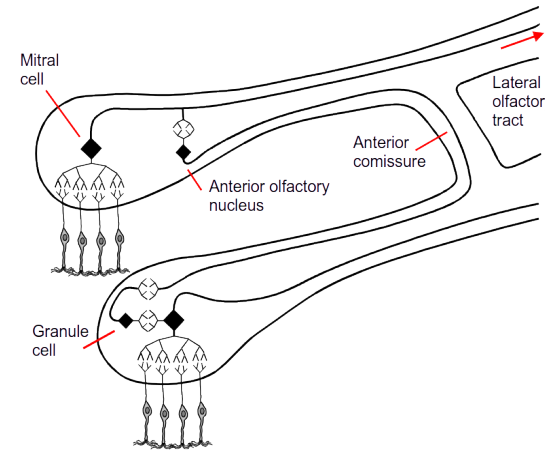
Which 4 locations does the lateral olfactory tract synapse on?
Olfactory tubercle
Pyriform cortex
Amygdaloid complex
Entorhinal cortex
Where does the signal travel after the olfactory tubercle and what processing occurs?
Medial dorsal nucleus of the thalamus
Then to Orbitofrontal cortex
Combines olfactory and gustatory signals combining
conscious perception of odour
What do the Pyriform cortex, the Amygdaloid complex and the Entorhinal cortex control in the higher olfactory pathway and how?
Control automatic subconscious effects
Amygdaloid complex projects to the Reticular formation which controls Arousal and the Hypothalamus to influence the Autonomic system
Entorhinal cortex projects to the Hippocampus, influencing Motivation, which projects to the Hypothalamus, Autonomic effects
Which system are the Amygdala and Entorhinal cortex part of?
Limbic system
What shape is the vomeronasal organ?
Blind ended tube
Where does the accessory olfactory bulb project to and what does it do?
the Amygdala
changes the reproductive and social behaviour
How is sex identification carried out in mice and what are it’s affects?
Done via pheromones
Default behaviour for male mice is to mate
agression is repressed
mating is increased
If pheromones show a female mouse then aggression repression pathway and horniness pathway are increased.
if pheromones show a male then aggression repression pathway and horniness pathway are repressed
How do pheromones work in humans/
Trance Amine associated receptors in the olfactory epithelium can detect volatile amines and change mood
What are the 3 types of papillae and their locations?
Circumvallate at the back of the tongue
foliate in the middle of the tongue
fungiform at the front of the tongue
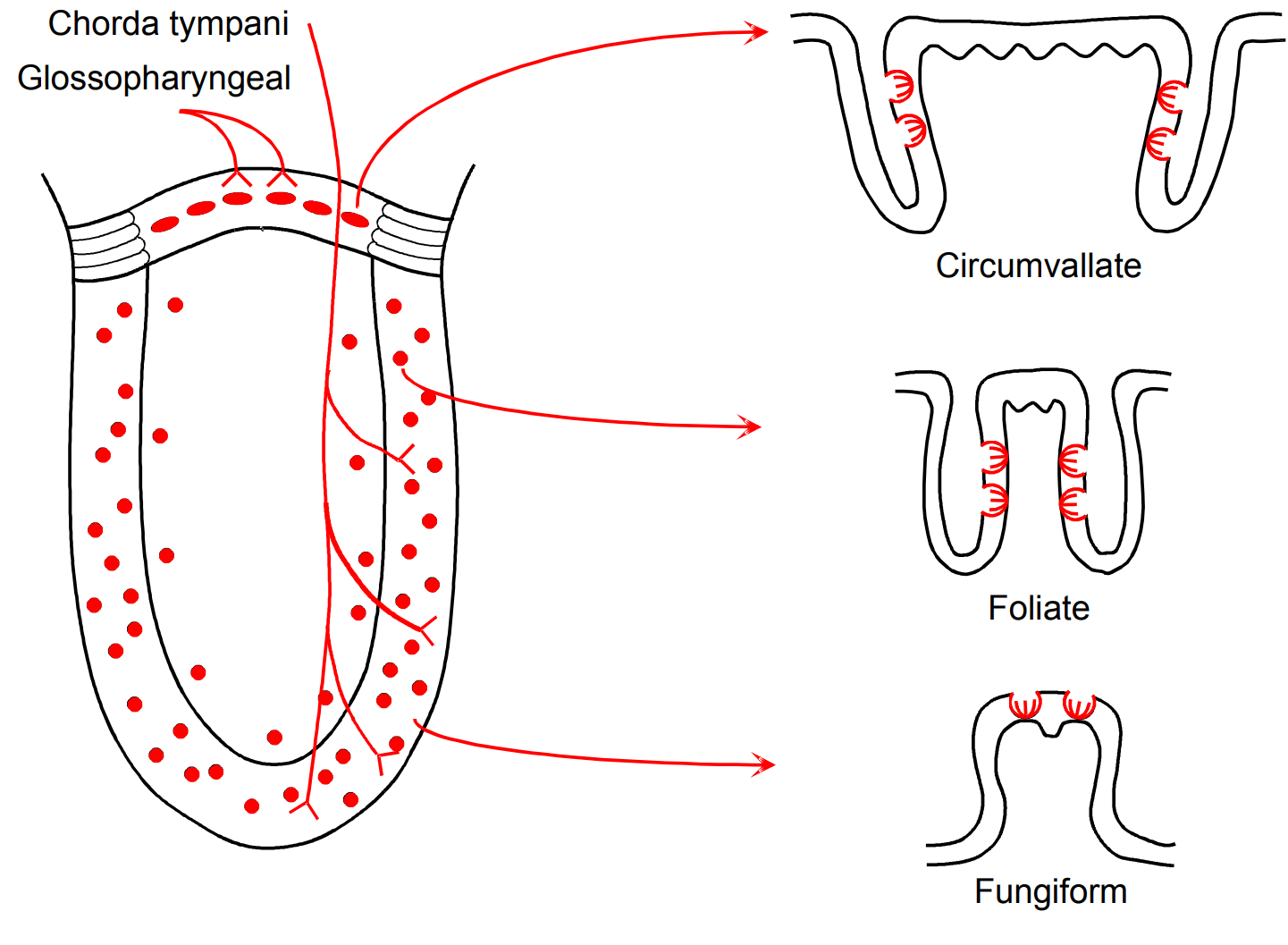
What is the structure and location of taste buds?
Found on papillae
Mixture of taste receptors and support cells in a hole on top of basal cells
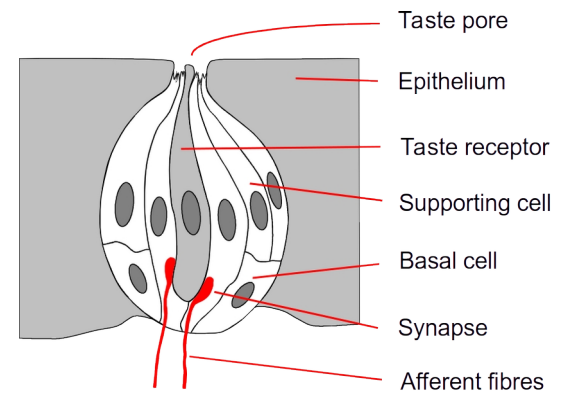
Why don’t taste receptors need to fire action potentials?
They are short receptors
What are the 2 types of taste receptors in a taste bud and their differences?
Receptor cell (don’t connect to an afferent)
Presynaptic cell (connects to an afferent)
Where do the afferent fibres project to from the taste bud?
To the chorda tympani and the glossopharyngeal nerves
Which cells sense each taste?
Complex molecules (Sweet, bitter, umami) by using receptor cells using GPCRs
Salt is sensed by a subset of receptor cells
Sour is sensed by pre-synaptic cells
What is the Structure of the receptor molecules for Bitter, sweet and umami?
Sweet and Umami are heterodimers
Umami is tas1R1 and tas1R3
Sweet is tas1R2 and tas1R3
Bitter doesn’t dimerise
Each receptor is one of a family of about 30 different tas2Rs
What is the relative sensitivity for tasting the complex molecules and why?
Umami and Sweet are insensitive as a food is only worth eating if there’s lots of sugar/protein
Bitter is very sensitive as it senses dangerous alkaloids
How does transduction occur in taste cells?
GPCR detects target
beta-gamma subunit activates PLC
turns PIP2 into IP3 and DAG
IP3 opens Ca2+ channels in sER
Ca2+ opens Trpm5 channel to let in Na+ and Panx1 to let out ATP
ATP acts as a purinergic transmitter
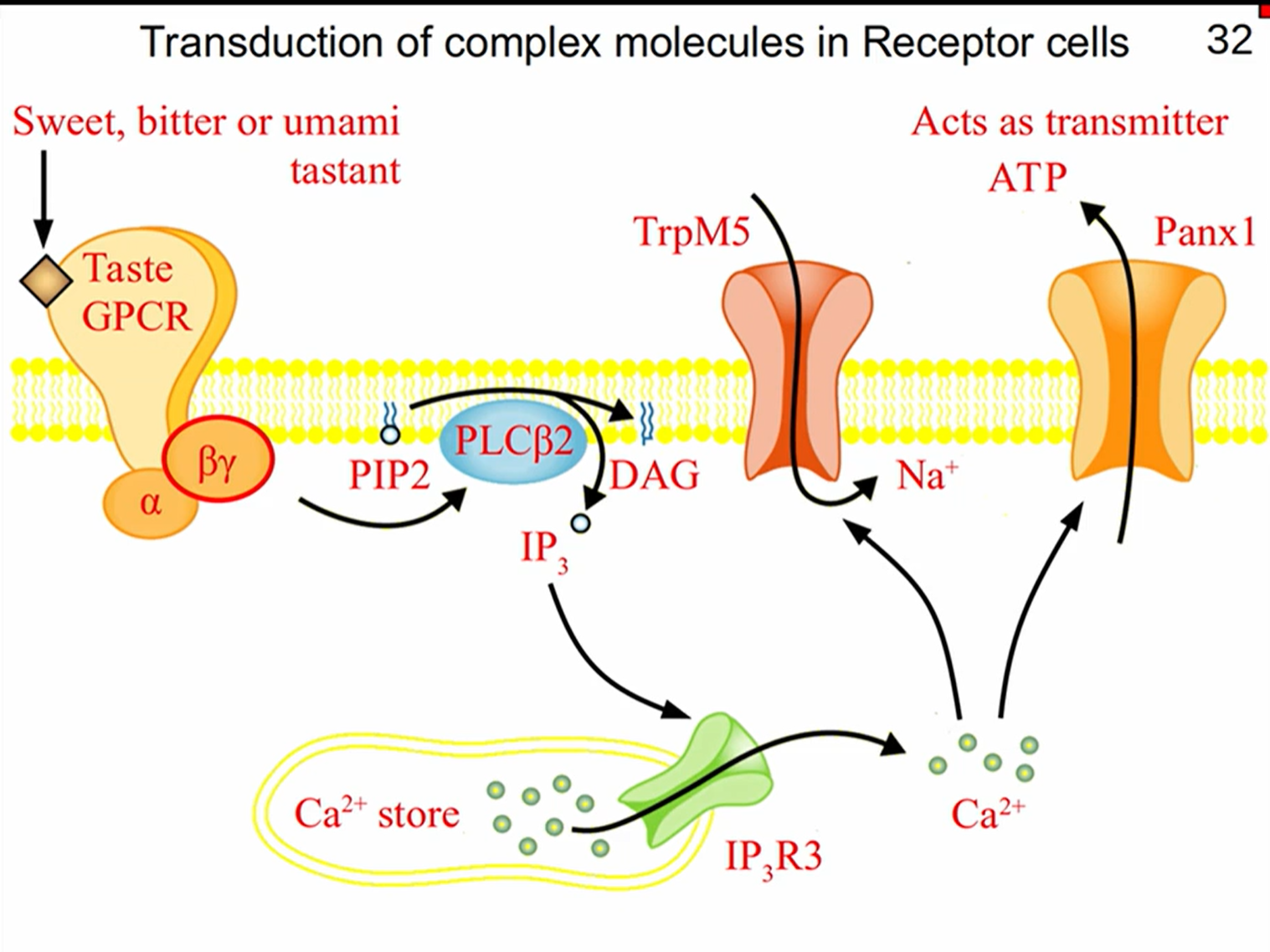
How is sour transduced and why do different acids at the same pH taste different?
Sour is caused by acids
Acids dissociate into protons and their conjugate base
Protons can cross the membrane of the cell
inside cell protons block K+ channels
cell drifts towards threshold and then opens Ca2+ channels for the spike
As it’s a presynaptic cell, the spike causes neurotransmitters to be released into the synapse
Different acids have different sourness at the same pH because
How is salt transduced?
Uses a modified taste receptor
Na+ enters the cell via epithelial Na+ leak channels
These interact with Gap junction hemi-channels to let more Na+ in
Stimulates CAHML channels to let ATP out to stimulate the afferent nerve
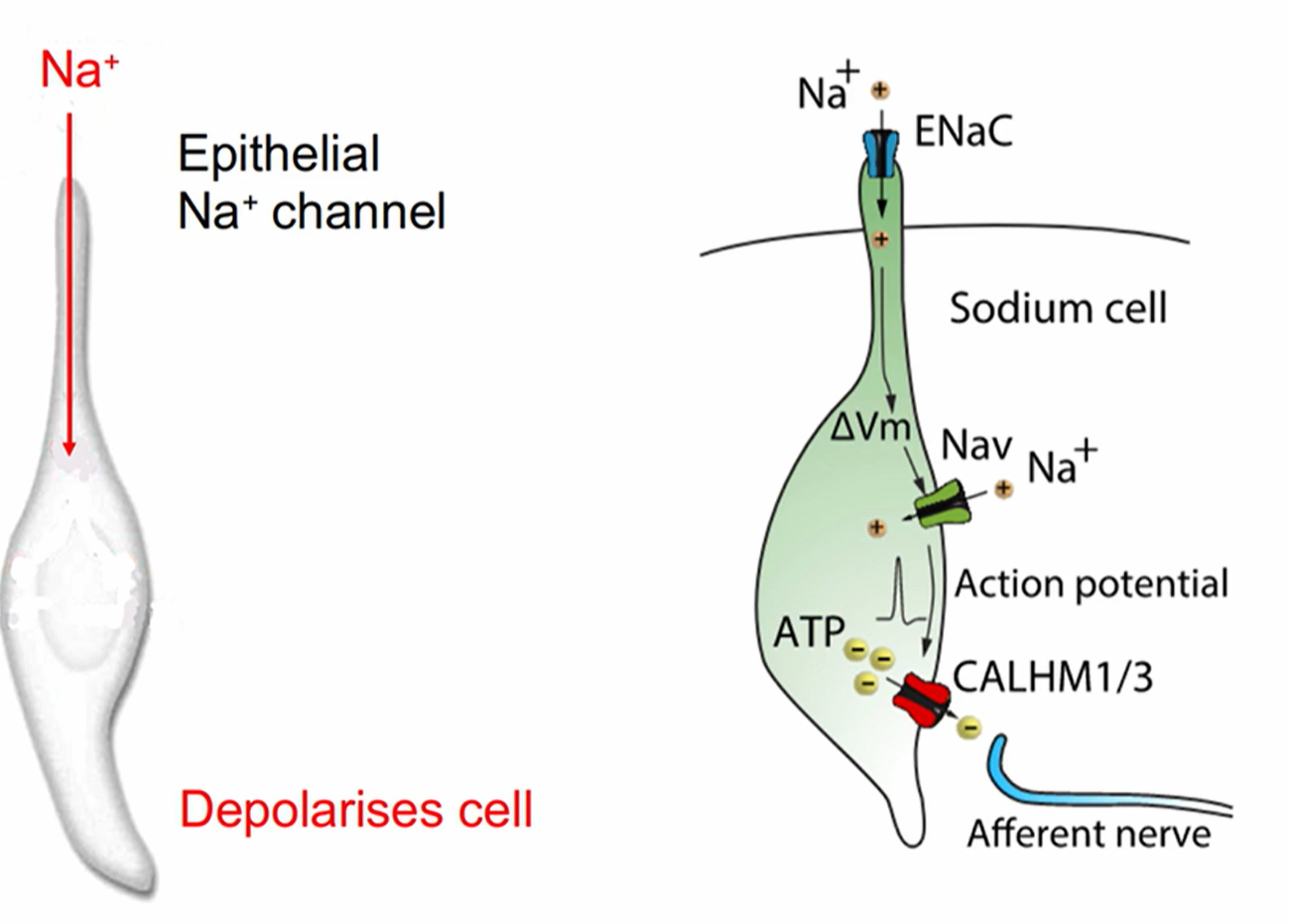
What receptor does wasabi stimulate?
TrpA1
noxious cold thermoreceptor
What is the neural pathway for taste and what is processed in each destination?
From tongue
cranial nerves VII and IX
From pharynx
cranial nerve X
gustatory nucleus
Ventral posterior nucleus of the thalamus
Operculum and insula
Cortex
orbitofrontal cortex
palatability
amygdala
motivation
lateral hypothalamus
digestion

Where do taste an olfaction overlap in the brain?
Amygdala and orbitofrontal cortex to gage pleasantness
Information continues up the pathway together
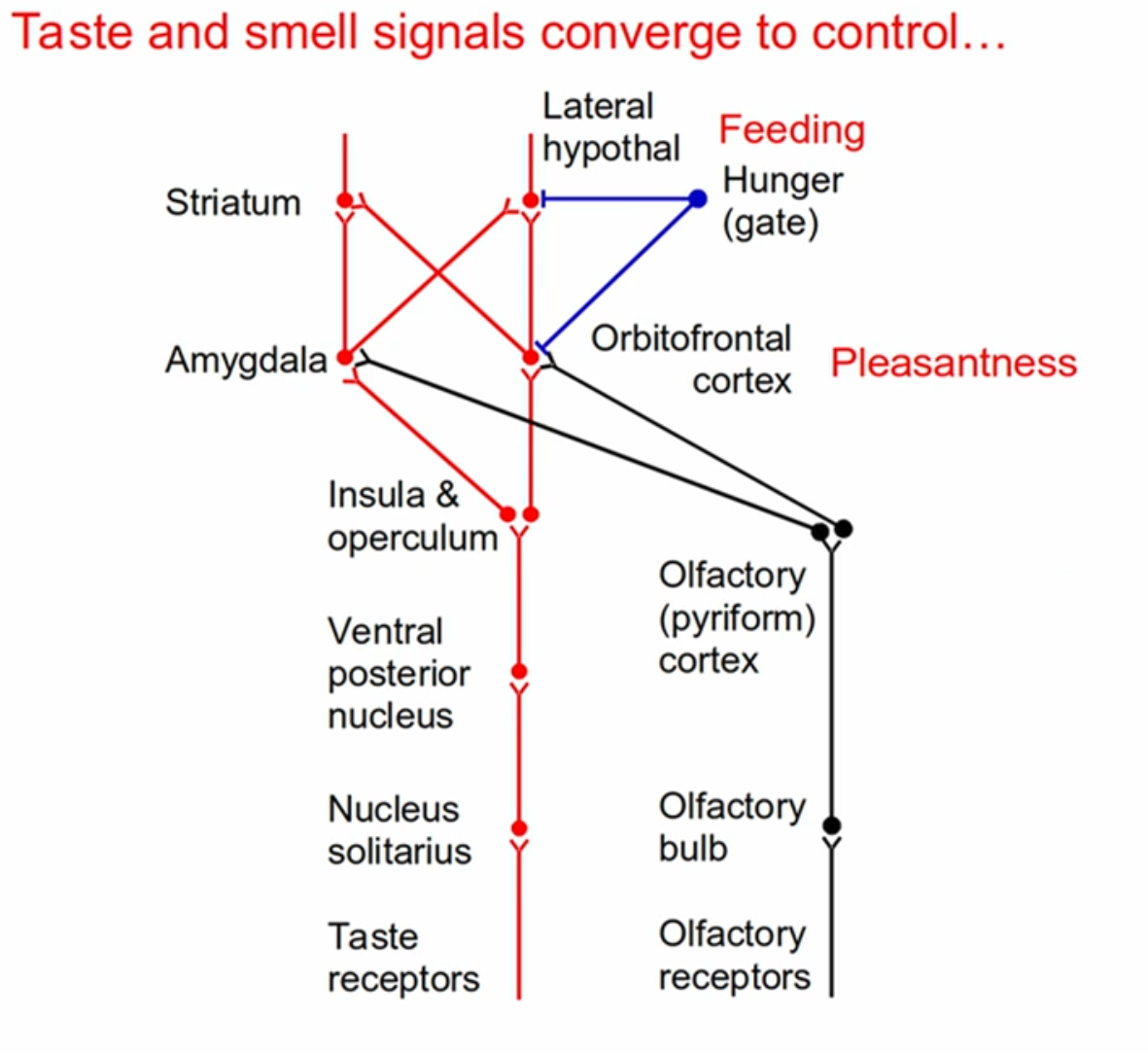
What is the neurotransmitter used between pre-synaptic cells and the affterent fibres in taste?
Serotonin (5-HT)
How does local processing occur in the taste bud?
Receptor cells release ATP which stimulates both Presynaptic cells and free afferents
Afferent axon releases glutamate to stimulate the presynaptic cells
Presynaptic cells release 5-HT and ACh to inhibit receptor cells
